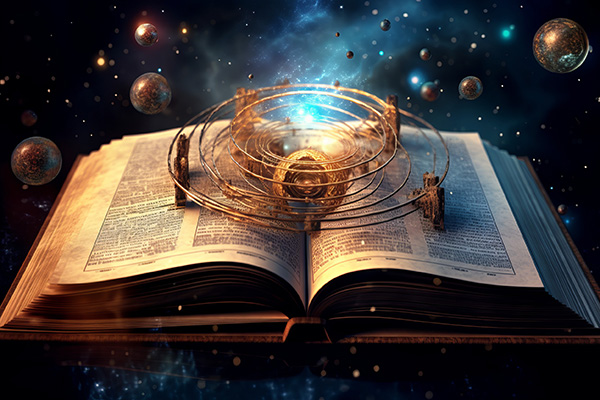mysticism
The Spiritual Significance Of Colors
 Color permeates our very existence, profoundly affecting our homes, our work environments, the food we eat and the clothes we wear.
Color permeates our very existence, profoundly affecting our homes, our work environments, the food we eat and the clothes we wear.
In every facet of our lives, color exerts a significant influence, shaping our moods, behaviors, and spiritual well-being.
In Kundalini Yoga, for example, teachers traditionally wear white outfits made of natural fibers, along with a white head covering. This custom is not just for practical or aesthetic reasons.
Just as the color white deflects the sun’s rays while black absorbs them, white also deflects negative energy while black attracts and absorbs it.
This practice thus serves a dual purpose: it symbolizes the purity and spiritual clarity that the teacher exemplifies, and it also protects the teacher from negative energy that may emanate from his or her students.
Kundalini Yoga can attract a wide range of students, from those who are highly developed spiritually to those who struggle with emotional instability. The white attire acts as a shield against negative energy that may be projected or “dumped” on the teacher.
In particular, the head covering protects the seventh chakra, which is located at the top of the head. This chakra is essentially our ‘spiritual umbilical cord’ that connects us to God, Source, Spirit, the Divine, so its protection is crucial.
Understanding The Higher Self
 In modern spirituality and metaphysics, the concept of the “higher self” is generally considered a cornerstone of spiritual awareness and conscious living.
In modern spirituality and metaphysics, the concept of the “higher self” is generally considered a cornerstone of spiritual awareness and conscious living.
The idea that we have a “higher self” is found in many spiritual and mystical traditions, although it may be called by different names and understood in different ways.
Despite these differences, the underlying idea is that there is a higher, more enlightened aspect of our being that we can connect with and embody.
Often mentioned in discussions of intuition, mindfulness, enlightenment, and the search for deeper meaning, the higher self is seen as a guiding force or eternal soure of wisdom that transcends our everyday consciousness.
Yet despite the common use of this term in modern spiritual communities and teachings, there remains a great deal of confusion and variation in how the higher self is understood and interpreted. There are many different opinions and beliefs. Some see it as our inner connection to the divine or universal consciousness. Others see it as the true spiritual essence, free from the limitations of the human ego. And some simply see it as an alternative term for our eternal spirit or soul identity.
In my experience, most of the confusion and misunderstanding arises because the higher self is mistakenly seen as a distinct and separate entity from the soul or spirit. From this perspective, the higher self is seen as entirely separate from our soul, representing our connection to something greater than ourselves, to the divine or universal consciousness.
My Spiritual Encounter With A Bear
 Imagine venturing deep into the forest, sunlight streaming through the ancient trees. The air is crisp, alive with the gentle whispers of nature. Suddenly, a colossal bear emerges from the underbrush, its presence a primal force in the serene scene.
Imagine venturing deep into the forest, sunlight streaming through the ancient trees. The air is crisp, alive with the gentle whispers of nature. Suddenly, a colossal bear emerges from the underbrush, its presence a primal force in the serene scene.
Well, chances are this isn’t just another wildlife encounter – it’s a potentially powerful spiritual experience, imbued with profound symbolism.
My psychic mentor and I once had such a remarkable encounter with a bear that brought me some deep spiritual insights.
The forest has always been a happy place for me, and for this particular long-term retreat, I rented a cabin in the Great Smoky Mountains National Park in Gatlinburg, Tennessee. One crisp fall evening, while my friend was visiting me and we were enjoying the tranquility of twilight on the back porch, a large black bear wandered into the back yard.
At first, we were both gripped with fear. Seeing such a powerful creature up close is both awe-inspiring and very intimidating! Fortunately, the bear paid us little attention as he calmly foraged for food, his movements deliberate and unhurried.
After the initial shock, we found ourselves mesmerized by his presence. I am always on the lookout for signs and synchronicities from the universe. Decades of spiritual work have taught me that nothing is accidental or random, especially when you are in the wilderness.
From Ancient Mystics To Modern Psychics
 Psychics and mediums have been around since the dawn of human civilization: from the shamans in indigenous cultures, to the oracles of ancient Greece and Rome, the seers and druids of Celtic societies, the sages of ancient China, and the prophets of ancient Middle Eastern cultures.
Psychics and mediums have been around since the dawn of human civilization: from the shamans in indigenous cultures, to the oracles of ancient Greece and Rome, the seers and druids of Celtic societies, the sages of ancient China, and the prophets of ancient Middle Eastern cultures.
Some famous examples include Pythia, the Oracle of Delphi in ancient Greece; the Celtic soothsayer Myrddin Wyllt, also known as Merlin in later Arthurian legends; the Chinese wu (shaman) Jing Fang; Black Elk, the renowned Native American holy man of the Oglala Lakota Sioux people; Isaiah, the renowned prophet of the ancient Near East; and Agastya, the revered Hindu sage and seer.
Throughout human history, in different cultures and societies, there have always been individuals with mystical abilities who held important roles within their communities and served as intermediaries between the physical world and spiritual realms.
They served as conduits of divine wisdom, predicting future events, providing insight into hidden truths, and offering guidance on various matters. They often acted as special advisors to tribal leaders, rulers, and kings, and typically played an important role in the moral and spiritual direction of their people.
The term “psychic” comes from the Greek word psychikos, meaning “of the soul, spirit, or mind.” In Greek mythology, Psyche was the goddess of the soul. Her name literally means “soul” or “breath.” Over time, the term came to encompass aspects of the mind beyond the ordinary.
Enhance Your Spiritual Practice With Rune Yoga
 As a professional psychic advisor, my days are filled with interpreting runes, connecting with energies, and guiding others through their life challenges and spiritual journeys.
As a professional psychic advisor, my days are filled with interpreting runes, connecting with energies, and guiding others through their life challenges and spiritual journeys.
To restore my own energy, maintain my inner balance, and ensure my holistic well-being, I engage in various spiritual self-care practices that nourish my own mind, body, and soul.
One of my favorite pursuits used to be traditional Indian yoga, until I discovered its Norse-Germanic counterpart known as Rune Yoga, Rune Standing, Rune Stances or Runic Postures.
Rune yoga is an ancient practice that essentially blends the ancient wisdom of the runes with the holistic benefits of similar mind-body traditions such as yoga, tai chi, qigong, pilates, and aikido.
Traditional yoga has always been a sanctuary for me, a place to reconnect with my body and mind.
But as I became so deeply immersed in the world of runes for my work, I found my way to rune yoga as an alternative practice that felt like a natural extension of my interests and professional experience.
Runes are the letters in a set of related alphabets, known as the runic alphabet, that were used to write various Germanic languages before the adoption of the Latin alphabet.
They were used primarily in Northern Europe, Scandinavia, the British Isles, and Iceland from about the 2nd to the 17th centuries. The word “rune” itself comes from the Old Norse word rún, meaning “secret” or “mystery,” underscoring their mystical and symbolic significance in ancient times.
Accessing Your Own Akashic Record
 The ability to access the Akashic Records is traditionally considered a special gift that only a select few prophets or gurus are privy to. It is often mistakenly considered an esoteric practice that only the spiritually advanced or those of us with unique mystical abilities can perform.
The ability to access the Akashic Records is traditionally considered a special gift that only a select few prophets or gurus are privy to. It is often mistakenly considered an esoteric practice that only the spiritually advanced or those of us with unique mystical abilities can perform.
However, this outdated perception is rapidly changing. The modern spiritual landscape embraces the understanding that, with some dedication and practice, anyone can learn to access their own Akashic ‘file.’ This shift is rooted in the notion that these records are not exclusive, but universal.
The records are a karmic birthright, freely available to all who seek to access them with sincere intentions and an open mind, for the simple reason that having free access to one’s own karmic “data” is beneficial to your soul evolution.
The concept of the Akashic Records has fascinated mystics, spiritual seekers, and esoteric scholars for centuries. Rooted in various religious and spiritual traditions, it is described as a universal compendium of all events, thoughts, words, emotions, and intentions that have ever occurred in the past, present, or future.
This metaphysical “library” or “database” exists in the non-physical and underlies the universal field of consciousness and our entire existence. In Sanskrit, the term Akasha (आकाश) is derived from the root word kas, which means “to radiate,” “to shine,” or “to be visible.” The prefix “a” intensifies or negates the root meaning, giving “Akasha” various interpretations such as “ether,” “space,” or “sky.” In Hindu philosophy Akasha is considered one of the five elements that make up the physical world.
12 Universal Spiritual Laws You Need To Know
 Most spiritual seekers today are familiar with the universal Law of Attraction. But did you know that there are several other universal spiritual laws that govern our existence?
Most spiritual seekers today are familiar with the universal Law of Attraction. But did you know that there are several other universal spiritual laws that govern our existence?
The origins of our understanding of the universal spiritual laws are deeply rooted in various religious and philosophical traditions, as well as in the collective wisdom of human experience since the dawn of time.
Many of these spiritual laws are rooted in ancient wisdom traditions from around the world. These traditions evolved over thousands of years as sages, scholars, and spiritual leaders refined and elaborated upon the fundamental principles that govern all existence.
Mystical traditions within various religions have also played an important role in the development and interpretation of these spiritual laws. Mystics tend to explore the deeper, esoteric aspects of their faith, seeking direct experience of divine truths. Their insights and revelations have contributed to a deeper understanding of spiritual principles beyond literal interpretations of religious texts.
Philosophical traditions in ancient Greece, China, and other civilizations also contributed to the development of spiritual principles that later evolved into universal laws. Thinkers such as Plato, Aristotle, Confucius, and Laozi explored concepts related to ethics, metaphysics, and the nature of reality that influenced later spiritual teachings.